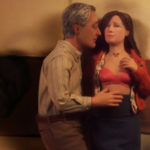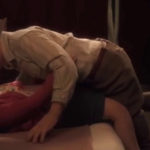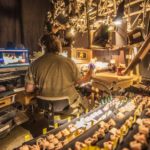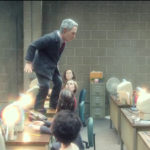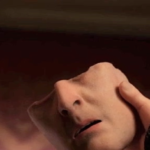Anomalisa is about life, or rather what happens in reality when we try to live life. Not all glitz and glamour, just a lot of awkwardness, boredom, dissatisfaction and the occasional glimpse of something special: not like in the movies, in other words.
This quality of summing up the human condition and the dilemmas of living is what won the film many plaudits, though the smart bit is that writer/director Charlie Kaufman and co-director Duke Johnson chose to make it as a stop-motion animated movie made with models created by 3D printing.
All the history and technical wizardry stuff is quoted below from Wikipedia, but the key here is what you can do with puppets (ones with sectioned faces that look like they might be robots, and indeed are in a dream sequence) that you can’t do with real actors. Show them having sex in glorious technicolour detail is undeniably one thing that tends not to happen outside porn films, but there is more, much more that puppets can convey, surprisingly so – and that includes humanity.
Anomalisa goes further than almost any animation in exploring ways for human emotions to be represented without the use of real people than I’ve ever seen.
The actual narrative is fairly mundane; it deliberately employs clichéd circumstances to demonstrate the prosaic nature of the life of customer service expert Michael Stone (voiced by our own David Thewlis), the principle protagonist and dissatisfied husband and father, in a Cinncinati hotel to promote his latest book. He meets an old flame but that turns out to be a disaster too.
That everyone else appears the same to Stone is demonstrated by the use of Tom Noonan to provide all other voices bar one, male, female and children alike. This sounds incongruous, even if there is a point to it, but therein lies the grand design of the film: our anti-hero is lonely but lacks all hope for anything turning out better.
The only woman who to Michael sounds different is a shy, diffident and self-conscious woman called Lisa, voiced by Jennifer Jason Leigh, who on a night out drinking with Stone and her friend. The friend is the one Lisa expects to be invited back to Stone’s room but Lisa is his girl. They talk, sing, intimacy and have awkward sex. He christens her an anomaly – “Anomalisa”, geddit?
Thereafter Michael has a nightmare in which everyone is chasing him for sex, then wakes suggesting he and Lisa should run away together, even if her eating habits irritate him at breakfast. Like everything else in Michael’s life, it doesn’t quite go according to plan. His conference speech certainly doesn’t.
The meeting with Lisa turns out to be a brief glimpse of hope amid the sad world of Michael Stone. He returns to LA for Christmas, gives his son a present of an animatronic Japanese doll he saw in Cincinnati, rejected of course. But a letter from Lisa says they will meet again. Maybe at the end of this downbeat tale there is hope after all?
Some critics, including our very own Mark Kermode, raved over Anomalisa, possibly because it does the exact opposite of what American movies usually do – and maybe why real life stars would not want to play these characters, were a live action version ever on the cards. What they represent is what life is like for the rest of us, the downtrodden masses, those without an extraordinary gift, those whose lives are lived without hope.
For the record, other critics and punters detested the film with a passion, possibly because it remains mundane, provides a relatively straightforward linear narrative and is possibly a lost opportunity. I know at least one person who thought it boring – but to be entirely unaffected by the rich human spectrum of emotional conditions you would probably need to be addicted to action movies or be a sociopath.
See for yourself, though I can’t promise an entirely uplifting 90 minutes of entertainment. But then you knew that, didn’t you?
Anomalisa was written in 2005 for the Los Angeles run of “Theater of the New Ear”, described as ‘a concert for music and text, or a set of “sound plays”‘ by Carter Burwell, who commissioned and scored them. It was a double bill with Kaufman’s Hope Leaves the Theater, and replaced Sawbones, by the Coen Brothers, from the earlier New York run after that play’s actors were unavailable. Anomalisa was credited to the pen name Francis Fregoli: a reference to the Fregoli delusion, a belief that different people are in fact a single person who changes appearance or is in disguise. The 2005 performance had Thewlis and Leigh sitting on opposite sides of the stage, with Noonan in the middle; Burwell conducted the Parabola Ensemble, and there was a foley artist.
Kaufman was initially opposed to turning the play into an animated film, saying that the play had “a disconnect between what’s being said on stage and what the audience is seeing – there’s Tom playing all these characters, there’s Jennifer and David having sex while they’re really just standing across the stage from each other and moaning. You’d lose that.” The film was reinvented, although its script was described by The Guardian as “virtually the same” as that of the original play.
The film raised its budget on Kickstarter so as to “produce this unique and beautiful film outside of the typical Hollywood studio system where we believe that you, the audience, would never be allowed to enjoy this brilliant work the way it was originally conceived.” Pitched as a short film “approximately 40 minutes in length,” 5,770 backers pledged $406,237 to help bring the project to life. After the success of the Kickstarter initiative, additional funding was secured by the film’s production company, Starburns Industries, and the film was expanded to a feature length.
The puppets were created with the use of 3D printers, with multiple copies of each character. 18 Michaels and six Lisas were created. While Johnson was told that such realistic animation would be “disturbing and off-putting,” he disagreed. To that end, a goal of the film was for viewers to “forget they were looking at something animated and just get wrapped up in the scene,” further explaining that “the challenge we felt with so much animated stuff is that you’re always conscious of the animation, and we kept asking, ‘What if we could escape that? What would it be like?'”
The film was in production for more than two years, gathering only fractions of seconds of footage each day. Kaufman has stated that on some days only about twelve frames (1/2 second) were shot.




